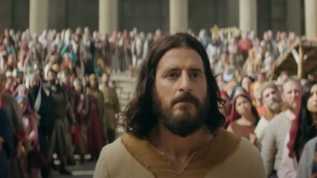Some 3,000 Anglicans gathered at St. Paul’s Cathedral in London, England, to celebrate the 1,400th anniversary of the re-organization of the diocese of London, May 22, 2004. The festive day also marked the feast of Bishop St. Mellitus – the prelate who re-found the diocese in 604 AD.
To mark the celebration, the Archbishop of Canterbury Rowan Williams delivered a sermon based on Acts 15 – a chapter that speaks of the reconstruction of David’s fallen tent.
“The history of the Church of London is the history of the Church of God. There is no straight line of comfortable development, no smooth plot with a happy ending,” said Williams, head of the 77-million member Anglican Communion. “The Church's real history, the Church's spiritual history, is always and only one thing - or rather one thing seen from two angles. Humanly it is a story of failure or sin and recovery, of the utter unpredictability of events; God does not promise that we shall be protected from events, that we shall be in control, he only tells us that his own presence and promise are never touched or changed by events.”
Currently, the Reverend Richard Chartres leads the diocese of London.
The following is the full text of the Archbishop’s sermon, as released by the Anglican Communion News:
St Paul's Cathedral
Saturday 22 May 2004
'After this, I will return and rebuild David's fallen tent. Its ruins I will rebuild and I will restore it...says the Lord' (Acts 15.16-17).
You have an archbishop who finds himself in a very paradoxical position. I have spent years explaining to anyone who would listen that of course St Augustine was a latecomer to the Christian scene in these islands, where brave missionary Celts had been doing all the hard work for a long time. A slightly selective version, I realise, given that the Welsh of that era were determined not to convert any English if they could possibly help it, but it's a good story...And now here I am in Augustine's seat, trying hard to be a missionary Celt, but suspecting that the hard work is again being done by someone else.
And the history of the great church of London, where plenty of hard work is unmistakably going on now, is an intriguing part of that complicated story of our Christian beginnings in this land. I shall be inviting you to celebrate not only the arrival of Mellitus and the Roman mission, but a history that goes back a bit further. For we first meet the Diocese of London in 314. Bishop Restitutus signed in at the Council of Arles in that year, along with the bishops of York and somewhere else - possibly Lincoln, possibly (as I of course believe) Caerleon - and joined in the discussions of the date of Easter, the rebaptising of heretics, the evils of priests and bishops moving from one job to another, unauthorised celebrations of the Eucharist by people not ordained priest, the remarriage of divorcees, and suchlike remote issues. They agreed about the excommunication of practising charioteers and strolling players, and warned magistrates of the spiritual dangers of their office.
Restitutus must have come home to his church (possibly somewhere around Fenchurch Street) feeling satisfied that things were looking up for the Church. The most savage persecution yet known had just finished, and had claimed a martyr in London itself, probably Restitutus's predecessor; but now the emperor was friendly, the Church was respectable, and it was possible to begin to sort out the chaos of disciplinary problems that had grown up in the hard years of violence and danger. Did he, I wonder, think how providential his own name was - a name that suggests he or his father or grandfather was a freed slave? Restituo, says the Latin dictionary, 'replace, restore, rebuild, renew, give back, return (to a condition)'; Restitutus's church was a church restored and renewed, and he surely believed, as did so many in that age, that Constantine had brought the Kingdom of God very close.
Nearly a hundred years later, in 410, Restitutus's successor watched, incredulous and desperate, as the legions marched towards their ships and deserted the colony. He will have known, like all the citizens of London, that this was the end of Christian civilisation. The barbarian pirates were on their way and, beyond a makeshift Home Guard, as ineffective as Dad's Army, nothing stood between the city and disaster. If there was a bishop in London by 514, he will have lived in a tiny hut in the middle of vast ruins, ministering to a few villagers, while the warbands from the North Sea pushed past on their way to the inland kingdoms. It was all over: he had no clergy to whom to pass on the succession, and the people were leaving as and when they could to flee westwards.
We don't know what followed; when Mellitus arrived, there seems to have been no relic of Christian presence. But once again, there will have been the feeling of a 'restitution', a new start and a new hope; and once again this was bitterly disappointed with the coming of a new regime and the expulsion of the bishop. Like Restitutus, Mellitus made the journey to France - but not to take part in a confident and businesslike council, simply to wait for better times, for a call to replace, restore, rebuild. Bishops of London have always needed to be both tough and patient.
And so it has gone on. Nicholas Ridley, at the end of Edward VI's reign, ordering his senior associates off to refuge on the Continent while he sat and waited for Queen Mary to unmake his life's work and destroy him; William Juxon, after attending Charles I to his death, sitting out the long years of the Commonwealth to emerge as a reluctant archbishop in 1660. The work to restore and beautify this great church of St Paul in honour of the Restoration destroyed by the Fire; and then the unexpected and revolutionary splendour of Wren's creation. The drab, even disgraceful, services of the early and mid nineteenth century - when the young Frederick Temple, future archbishop, was told by a verger to go home when he wanted to stay for Holy Communion, so that the Canon in Residence should be spared the bother of having to celebrate; and then Bishop Blomfield's whirlwind energy (sometimes, it is true, more enthusiastic than judicious) planting churches throughout the vast metropolitan area, and later still the crowds flocking to hear Liddon and Scott Holland expound doctrine and prayer and social vision at the biggest popular services the cathedral has ever seen. The stately dullness of Dean Inge's regime; and the Blitz, when St Paul's stood as a true icon of the gospel's stability in the middle of terror, and the post-war restoration of the cathedral to its true - and continuing - place as a beacon of prayer and Christian reflection. The famous photographs of the Dome in wartime might well do for an illustration of the motto of the Carthusian monks who were once such a significant presence in this part of London - 'The cross stands still while the world turns'. And then the abundance and profusion of twentieth century development, with all the variety of the Anglican tradition more and more visible in the great churches of central London, from Margaret Street to Brompton; and the courageous willingness in recent years to tackle and counter decline and to engage with the new social realities like the transformation of the Docklands.
Replace, restore, rebuild, renew; restituo. The history of the Church of London is the history of the Church of God. There is no straight line of comfortable development, no smooth plot with a happy ending. The Church's real history, the Church's spiritual history, is always and only one thing - or rather one thing seen from two angles. Humanly it is a story of failure or sin and recovery, of the utter unpredictability of events; God does not promise that we shall be protected from events, that we shall be in control, he only tells us that his own presence and promise are never touched or changed by events. And we have to learn this day by day and century by century. But this begins to show us the story from another perspective - not just as a story of failure and recovery but as a story of cross and resurrection. We cannot tell just how human sin will interrupt the work of God; because God does not force his gospel on anyone, and because human rebellion against God and human fear of other humans constantly unravels communion. But equally we cannot tell just where and how resurrection comes. In the darkness of failure and sin, Christ's cross is planted; he shares the dark, he carries the cost, he absorbs in his infinite compassion all that our rebellion means. And so there is always a divine action never exhausted working away in the very heart of darkness, and we can't tell when the light will come but we know that no darkness can extinguish it.
When we have put our own history, whether as individuals or as a church, into the context of God's action in the cross and the resurrection, we know that what is humanly speaking dark or light, disastrous or successful, hopeful or hopeless, is only the surface; these things come and go. When there is growth and conviction, we thank God and pray for it to continue; but when there is threat and failure, we turn gratefully to the same God, recognising that he is not destroyed by this. The true story beyond the surface level is that of God's endless reaching into darkness, God's life living its way into every moment of loss, guilt or pain, and drawing everything homewards to him.
And this means that the Church is always losing and recovering. Restitutus may have thought that the great recovery had happened and that history was drawing to a triumphant close; but his successors go on learning the deeper truth that there is no moment when we cease to be involved in 'restitution' - replacing restoring, rebuilding, renewing. God's love is always new, new every morning as the prophet tells us; so the Church is always new. To look at the Church's past is not to search for a golden age but to see precisely this truth of the unending renewal that comes from the unending presence of the crucified and risen One. In the words of the old creed, we do not believe in the Church in the sense in which we believe in God and his Son; we do not put our life's trust in the Church. We believe the Church, we trust what the Church says by its words and its history. We believe what is shown us in the constant and chaotic alternations of darkness and light, where sin is always at work but Christ is yet more deeply at work.
So when our church flourishes, praise God for his good gifts; when our church struggles and flounders, praise God for his faithfulness to us in our failure. And when, as so often, we see both together, we shall know that our heart must be with the God who is greater than both human success and human failure, who is simply there, given to us for ever in Christ and his Spirit of promise. Much of our perplexity as Anglicans these days comes from the mixed messages we receive - great growth and confidence, new initiatives, here and elsewhere; and also the fears of confusion and division, a bewilderment about where to look for true unity. But if we can keep our minds on God's fidelity, a fidelity amply shown in the history we celebrate today, we shall have something to say and share that is far more than our story, our achievement or lack of it. We are authorised and commanded to speak of a God who replaces, restores, rebuilds and renews because he never abandons. We have no choice but to announce this, as Restitutus and Mellitus and Ridley and Juxon and Blomfield and all the others did; we are under orders to repeat the promise of God to restore the tabernacle of his anointed. We know that in his hands, as we say at the Easter Vigil, are all times and ages; in his hands, our past and our future. He will restore all things.







